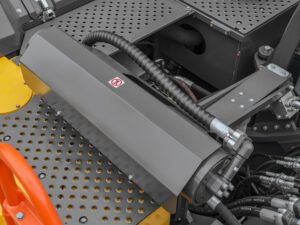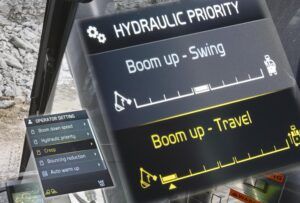Electro-hydraulics are enhancing off-highway automobile performance and effectivity, enabling machine management and offering the constructing blocks for energy-recovery programs. Trade consultants give perception into the evolution of this know-how and predict future developments
Over the previous three many years off-highway automobile designers have moved away from constructing machines which have hydraulics managed through mechanical programs and hydraulic pilot strains to utilising digital management – electro-hydraulics. However, whereas such programs are nicely established, the complete potentialities of this structure are nonetheless being explored.
Although hydraulic actions are nonetheless very a lot analogue in nature, the controls that operators use are nearly wholly now within the digital age, although the change didn’t come about in a single day, fairly through a gradual evolution.
That is borne out by element specs. Danfoss, for instance, after years of designing elements that could possibly be used with both mechanical or digital interfaces, has now fully transitioned its new elements to electro-hydraulics.
“The interface of our hydraulic merchandise has gone via three phases of evolution,” says Jeff Herrin, senior vp of R&D at Danfoss Energy Options. “The primary stage, relationship again a few years, concerned hydraulic and mechanical interfaces. For instance, a hydraulic pump managed by a lever that an operator might use to create the specified circulation.
“The second stage launched designs with each lever entry and digital management. This transitional part was essential as a result of trade shifts don’t occur in a single day. We would have liked a 10-year plan the place prospects who wished the legacy resolution might nonetheless get it, whereas we additionally constructed within the trendy, future resolution of a digital actuator that they may management.
“As soon as we reached a sure degree of adoption, we moved to the ultimate stage: merchandise particularly designed for digital management. These don’t carry the luggage of mechanical units, which add value and compromise designs.
“For many of our merchandise we’re already at this final stage so we now not design future merchandise with legacy interfaces. If prospects nonetheless want a mechanical interface, they will purchase the older era, which we nonetheless produce. They’ve completely different efficiency and security ranges, however they continue to be obtainable.
“Our focus now’s on designing hydraulics with digital interfaces as a result of we all know the longer term lies in electro-hydraulic programs. Actually, 100% of our new product improvement packages are focused in that route.”
New methods to maneuver
Lately Volvo Development Gear has used electro-hydraulic structure in its new Unbiased Metering Valve Know-how (IMVT), obtainable on 50-tonne EC550 and EC530 excavators.
“IMVT marks a departure from the standard mechanically coupled hydraulic programs and introduces clever digital management with quite a few variables,” says Sejong Ko, Volvo CE’s product supervisor for big excavators. “The outcomes are as much as 25% improved gas effectivity and higher operator management.”
IMVT permits further options utilizing a closed-centre valve-control system, which not like conventional open-centre programs, can cease or reduce hydraulic circulation via the principle management valve when there’s no demand for a hydraulic actuator. This considerably reduces gas consumption and eliminates the necessity for an eco mode.
It additionally makes use of unbiased cylinder management, sensing and controlling all sides of a cylinder’s chamber independently, with out utilizing hydraulic spools and pilot strains. This leads to extra exact management of the excavator’s actions.
“IMVT replaces conventional spools with poppet and electro-hydraulic valves in the principle management valve (MCV), lowering stress losses and optimizing valve management based mostly on load circumstances,” says Sejong Ko. “This results in quicker cycle occasions, improved regeneration and lowered circulation loss, with evaluation displaying a 20% enhance in productiveness.”

Hydraulic hybridisation
Regardless of potential vitality restoration ranges in off-highway automobile hydraulics being comparatively small when in comparison with the well-established hybrid programs utilized in hydraulic braking for automotive; lately, tighter emissions targets and rising vitality prices have supplied better demand, notably in excavators, which generate essentially the most carbon emissions of any automobile class within the off-highway world.
“Nevertheless it’s not a trivial factor to do in hydraulics,” says Herrin. “You need to add extra complexity with extra elements and circuits, and to do it, you completely need to have an digital system.”
The worth proposition for that extra complexity has traditionally been pretty poor, with OEMs having to make the commerce off on complexity versus profit. However the rising push for sustainability is driving innovation. “We did a refresh on our industrial pump product line,” says Herrin. “It was designed 30 years in the past and is now being refreshed and up to date to trendy specs. The spec for this new pump was, the truth is, to have the ability to get better vitality in addition to pump vitality.”
In 2020 Volvo CE first introduced that it had developed a Hybrid system for its excavators which recovers vitality immediately from hydraulic programs, not primarily by utilizing pumps, however as an alternative by the use of a hydraulic accumulator. It captures and reuses hydraulic energy, leading to as much as 17% enhance in gas effectivity and 15% discount in CO2 emissions. Lately the OEM introduced this Hybrid know-how could be added to its giant EC400 and EC500 40 and 50 tonne machines, having already been obtainable on 4 smaller automobiles within the vary – the EC380E Hybrid, EC350E Hybrid, EC300E Hybrid and EC250E Hybrid excavators.
“We do it by mounting a hydraulic accumulator simply behind the growth, and because the growth goes down, the high- stress oil that you simply use to retard the growth dropping goes into the accumulator as an alternative of being routed to the tank,” says Dr Ray Gallant of Volvo CE. “This provides the accumulator a high-pressure cost that’s then routed via help motors and put again into the cylinders on the upswing. Your entire course of is managed mechanically – the operator isn’t required to do something. He merely sees a small image on the sprint that tells him when his accumulator is charging and discharging.”

Volvo CE’s hybrid hydraulic know-how doesn’t generate electrical energy or require batteries for storing it. “It requires minimal elements – there aren’t any electronics to program and no management programs aside from system monitoring,” says Gallant. “Upkeep can be easy because the system is a basically a mixture of hydraulic circulation and valves.
There are different options which are extra reliant on pumps being able to working in a bi-directional method. For instance, pump- managed actuators handle movement primarily via pace and/or displacement management of particular person pumps, making the pump a central element within the system. It’s on this area that promising applied sciences embrace Danfoss’s Digital Displacement pumps, floating cup know-how, and high-speed pumps. “We count on these options to achieve the market over time,” says Hongsuk Kim, head of excavator medium and hydraulic platform at Volvo CE. “Significantly for electrically powered machines, the place bi-directional speed- managed pumps can get better vitality again to {the electrical} energy system.”
Sooner or later extra steps could possibly be taken with hydraulic vitality restoration applied sciences. For instance, dead-weight compensation programs. “These use extra cylinders and hydraulic accumulators working in parallel with the principle hydraulic movement management system and will supply benefits in particular functions,” says Hongsuk Kim. “These programs are comparatively easy and shouldn’t face important hurdles to reaching market readiness.
“A extra superior resolution is the frequent stress rail structure, which makes use of one or a number of semi- fixed stress ranges mixed with hydraulic accumulators. On this setup, pressure and pace are managed via hydraulic transformers and multi-chamber cylinders, which characterize state-of-the-art know-how. Even these superior programs require a number of independently managed valves, very similar to IMVT, demonstrating that our improvement efforts in IMVT are paving the best way for future improvements in hydraulic vitality restoration.”
“In the end electrified linear actuation will eradicate hydraulic fluid on machines”
Electromechanical actuators
Quite a lot of prototype automobiles, in addition to Bobcat’s manufacturing all-electric T7X and S7X compact observe loaders and skid steers, have completed away with conventional hydraulics altogether and changed them with electromechanical linear actuators. Herrin sees continued evolution within the discipline. He notes that Danfoss Energy Options is investing in electromechanical actuators as
a complementary product line to their electrification portfolio. Whereas the use circumstances for this know-how are at present modest, Herrin anticipates that, “as electrification takes a much bigger maintain in off-highway tools, finally electrified linear actuation will eradicate hydraulic fluid on machines. Rotary actuators (wheel drives, work capabilities) will probably be first, steering subsequent, and linear actuators final.
Volvo CE is already making use of electric-motor pushed actuators in a few of its excavators, and experiences constructive buyer suggestions. “You will need to notice that electrical motor-driven actuators can work along side hydraulics as an intermediate energy transmission medium or, in some circumstances, with out hydraulics altogether,” says Hongsuk Kim. “Nonetheless, each hydraulic and electrical programs have their respective benefits and limitations. We don’t imagine that one know-how will absolutely dominate throughout all functions.
At Volvo, we’re not dedicated to phasing out hydraulics however as an alternative deal with adopting the know-how that most accurately fits our prospects’ wants. We acknowledge the challenges related to electro-mechanical drives, particularly for linear movement functions. These challenges are much less pronounced for rotary drives, making them extra possible to interchange hydraulics now.”
Enabling automation
One of many key benefits of electro- hydraulics is that’s has enabled machine management – whether or not that be semi-autonomous driver help programs or full automation, with the ability to management actions through digital programs is a important enabler.
“One in all our flagship innovation programmes is round autonomy,” says Herrin. “There are only a few use circumstances for absolutely autonomous machines proper now, however there’s an entire lot for semi-autonomous, which imply operators will be much less expert, as a result of the machine can function itself in cycles which are repeatable.”
This pattern in direction of automation is driving the necessity for extra superior applied sciences. As Herrin factors out, “While you get into that house, AI and machine studying are required. It’s the core digital algorithm know-how that permits automation.”
This text first appeared within the October challenge of iVT


